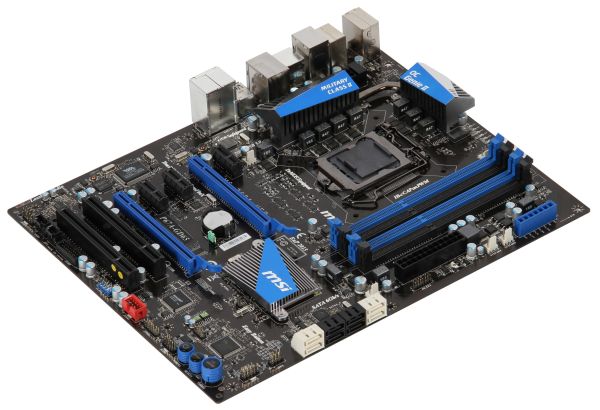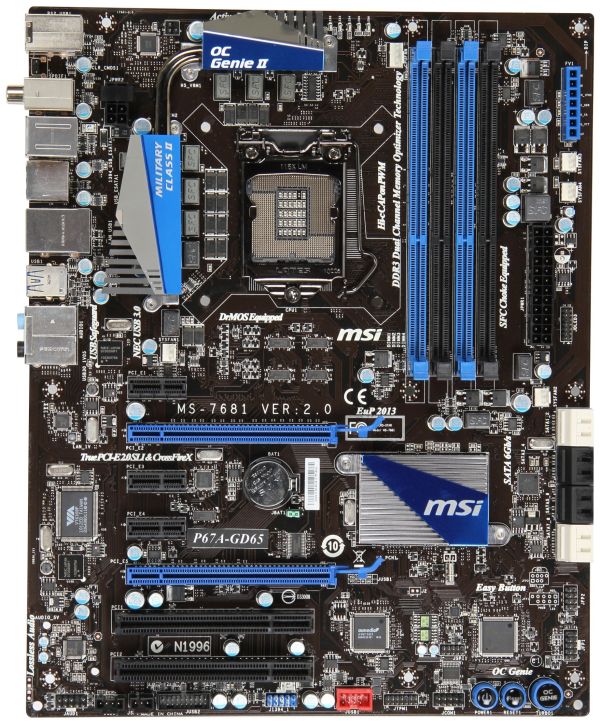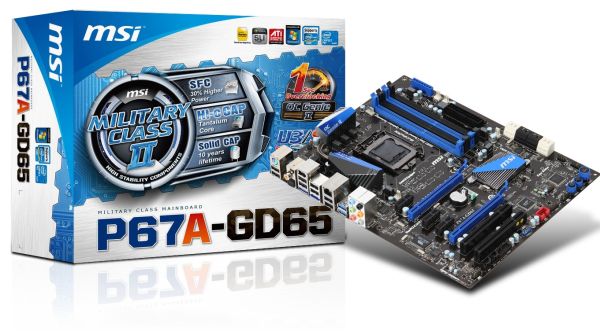P67 $190 Part 2: MSI P67A-GD65, ASRock P67 Extreme6 and ECS P67H2-A2
by Ian Cutress on May 10, 2011 1:36 AM EST- Posted in
- Motherboards
- MSI
- ASRock
- P67
- ECS
- Cougar Point
MSI P67A-GD65: Overview
On the face of it, the MSI P67A-GD65 is aimed at a variety of markets—for system builders and sellers, we have the OC Genie button which implements a very quick overclock setting; for sub-zero overclockers we get a series of voltage read points; and for the general enthusiast, we have a nice PCIe slot layout, and the standard array of P67 internals. After a run through with the MSI board, I can totally see it as a capable daily machine with that OC button, but beware with the software that comes with the board—there is a mountain if you want to look through it (and we cover it here), and some of it isn't even applicable.
MSI have a history of producing fine boards, but often with a few niggles. It is similar here with the P67A-GD65, predominantly in terms of the lack of USB performance against its competitors from a variety of price points, and the fact that MSI offer games (??!) in the UEFI! I'm being serious—read on to find out more.
MSI P67A-GD65: Visual Inspection
When you first look at the MSI P67A-GD65, you'll notice that the power delivery chokes are not what we've seen on our previous Cougar Point motherboards—here we have 'Super Ferrite Chokes', which supposedly result in a reduced power loss from the power delivery to the components, and are part of the MSI DrMOS topology.
Around the CPU socket, the VRM heatsinks are smaller than what we see on other P67 boards, and are connected by a heatpipe to cover the 6+2 phase power delivery. Along the top of the board are six LEDs which light up when various CPU phases are active—for the most part, we only observed either one or all six of them on at a time. In terms of fan headers around the CPU socket, we have one 3-pin at the bottom left of the socket and a 4-pin CPU fan header at the top right. Two others are on the right hand side of the board above the 24-pin ATX power connector and another header below this—meaning any dual fan all-in-one CPU water cooling (such as the Corsair H50) should be catered for if the pump is plugged into a fan header on the far right of the board.
On the other side of the memory slots, we have our voltage read points, where two GND points are alongside the PCH, VCC_DDR, CPU_SA, CPU_VTT and VCCP pins. MSI include these on several boards in their P67 range, and of real use only to a sub-zero overclocker pushing the limits of the board.
The SATA ports could possibly be better color coded, as the white ports are the SATA 6 Gbps, however the top are from the PCH, and the bottom are from the Marvell SE9128 controller. The black ones in the middle are the standard SATA 3 Gbps ports. On the bottom right of the board are the Power/Reset buttons, alongside the MSI OC Genie. We cover the operation of the OC Genie switch in our overclocking section. We don't see a debug LED here on the MSI board—you could consider that as it is technically the cheapest in this round-up that it is less likely to have one, and that our previous $190 round-up the ASUS and Gigabyte didn't have them either, but the ASRock P67 Extreme4 at $160 had one, as well as the ECS P67H2-A2 in this roundup.
The PCH heatsink is small and flat, and complementary with the blue-black livery of the board, which is quite aesthetically pleasing in my view—even if the white SATA ports and red power USB header stick out like a sore thumb. The PCIe slot layout is fairly good, with an unrestricted PCIe 1x at the top, a triple slot gap between the PCIe 16x slots (run at 8x/8x when two GPUs are present), and when the two PCIe 16x slots are populated with dual slot cards, a PCIe 1x is available between the cards and a PCI slot is available at the bottom.
The IO back panel is fairly standard—one PS/2 mouse/keyboard port, optical and coaxial S/PDIF out connectors, a clear CMOS button, two eSATA 3 Gbps ports via a JMicron JMB362 controller, eight USB 2.0 ports, two USB 3.0 ports in blue via a NEC uPD720200F1 controller, a single gigabit Ethernet port from a Realtek 8111E controller, a Firewire port, and the standard Realtek rear 8-channel HD audio with THX TruStudio Pro support.













27 Comments
View All Comments
maxhavoc - Tuesday, May 10, 2011 - link
The review states that the ASRock board doesn't support RAID on the SATA3 6.0 GBps ports but the NewEgg page says that it does. I can't find anything on the manufacturer's website. For a >$200 board to not support SATA3 RAID is pretty ridiculous so I'd like to know for sure. Does it or doesn't it?cbass64 - Wednesday, May 11, 2011 - link
I haven't seen the p67 extreme6 in person but I have used the extreme4 and all of the Intel ports (including the 2 SATA3 ports) support RAID. The other SATA3 ports use the Marvell controller and do not have RAID support. Any ports controlled by the PCH will be able to be RAIDed through the OROM.You should be able to RAID all 6 PCH SATA ports on this board.
TheJian - Wednesday, May 11, 2011 - link
I'm still waiting to see a review of something 95% of us will actually buy :) I'd also like to see a lot more discussion of the power phases on boards. 8/12/16/20, analog or digital? How does each affect the power bill etc. I haven't paid over $135 for my board (just missing SLI usually, but still lots of connectors always) since clear back to 386/486. These are commodity items now. I've sold a ton at $60-100 (used to have a PC business). What's with the $200 tag always garnering the most attention.It seems like the only products reviewed these days are flagships. The problem with that is we often aren't seeing what we can expect from what we'd buy in the store (most of us have no need for more than 1 vid slot - I'm shocked at how the industry has embraced something that almost nobody uses). This situation is far worse in SSD's. Where's the article on a family of drives (or just the bottom/top from two makers in the same family) and the performance hit you take buying the small 40/60/80/128 vs 256/300+ etc. I suspect 75% of your readers think they perform the same (as this has only been mentioned, not the major focus of an article). It's great manufacturers want to send you boards (expensive ones, duh), but not so great if not that many of us plan on touching anything over $150. Don't forget these are the same people buy vid cards based on $10 differences (LOL). I'm probably just ranting
Or how about an article on 3-5 cpu's (low, mid, top from the last few generations), with say 10-20 vid cards from the last few years to today. Most people would be surprised to know they don't have a slow PC, they just need a vid card and they suddenly have a new PC. Knowing which one is best (or overkill) for an Dual core Athlon X2, or P4, can be difficult to figure out (I haven't seen an article like this in years).
In short (heh), bring back some articles that help 95% of us out instead of 5%. I don't know anyone with more than a single vid card (never have, oops 3dfx long time ago), and it blows my mind that we have more boards from makers that have more than 1 slot than ones with only 1 slot. For what? To set benchmarks, that's about it. I don't know many that want to deal with the heat/noise or air conditioning bill for multiple cards. Very few people need that kind of power for current games (running 30in I guess).
Review was fine, just not what I think you're audience is about to rush out and buy. I am glad to see you testing USB/Lan/Sata on the boards.
ggathagan - Friday, May 13, 2011 - link
Yeah, you *are* just ranting.Anandtech is an enthusiast's site.
95% may not buy actually buy a flagship board, but I'll bet that 95% of us want to see the flagship boards reviewed and reviewed in detail.
Flagship boards are usually the first to come out with cutting edge tech, so they provide information that someone can use to determine what the performance across an entire family of boards will probably be.
A P67 board is a P67 board is a P67 board, so that which is discussed on a flagship board is applicable to the lower tier boards using the same chipsets.
As for the rest of what you want:
It's not like Anadtech and the other sites have this huge warehouse of all the parts they've ever reviewed and can just go back in the back room and whip up a dozen or so systems.
Additionally, exhaustive testing takes time. Even if they *did* have that warehouse, going back to test every conceivable combination of old and new hardware would be a waste of their time. They've already reviewed the old stuff.
AT puts out articles on a regular basis regarding their recommendations on top, mid, and lower-priced systems.
They may not put out thse articles every week, but they are frequent enough that you can get a general idea of cost and capability from them.
Do your own legwork, go back and read the past articles and figure it out for yourself.
It's a pretty safe bet that pairing a couple of 6970's or 580's with a P4 or an Athlon II is going to be a waste of money. Do you really need to know much more than that?
SSD performance has been discussed ad nauseam in the many articles that AT has put out. Lower capacity SSD's suffer in performance when compared to a larger SSD, but are still head-and-shoulders above the performance of a traditional drive. The reasons for that have been discussed exhaustively. The same holds for Intel vs. Sandforce vs. Marvell vs. Jmicro.
Do you really need every piece of SSD-related information repeated in every single article? Can't you just read all the articles yourself and come to your own conclusion?
ruzveh - Wednesday, May 11, 2011 - link
My msg is to and for Anandtech to reply: My concept of dual lan with teaming is really not clear and i am not able to understand ur lang as well.. Can u explain in a lay man term with example what does it mean and what its used for what it do?Is it something that one lan i can use for my cable internet and other lan port i can use to connect it to my local area network?
Or does it mean that i can use both the ports for internet or both for local intranet
Or does it mean that both of them i can use for boosting my internet sharing. If yes, then both the connection has to be same or different. Do i have to use both different ISP or can i use from same ISP? How does it work? Do i have to make it work having two different isp?
I mean can i make it like my 2mbps + 2mbps internet connection = teaming of 4mbps connection? Or is it like 2mbps + same 2mbps = 2mbps teaming?
Its really confusing and exciting to know. I always wanted to buy dual lan motherboard to use one port for internet and other port for connecting other computers for file sharing and internet sharing if possible.
I hope u have understood my query and 1000s of people have similar queries which is still unsolved across all fourms. I hope you wont dissapoint us. Thanks in advance
ggathagan - Friday, May 13, 2011 - link
Teaming within this context relates to network connections and is not applicable to internet connections.Other names for it are aggregation or trunking.
If your computer is connected to a network switch or to a firewall/router that has more than one LAN port, you can increase it's transfer speed by aggregating the computer's LAN connections together. This is done in software.
The computer and the network see the aggregated ports as a single network connection.
If you have two gigabit LAN ports on the system and you have the approptiate software, it is seen as a single 2 Gigabit connection.
The only reason to do it in this particular circumstance is if you have a home network or are in a networked environment at work.
Multiple internet connections *can* be set up in a similar fashion, but it takes specific hardware and multiple connections to your ISP.
That is both expensive and more complex than it's worth for the average user.
dweilbacher - Thursday, May 19, 2011 - link
"...in the OS I saw a constant 42x multiplier applied, with no SpeedStep down to 16x which is what we’ve seen on other boards."In the article you mentioned the OC Genie will OC, but turns off Speed Step (16x). So you are forced into a constant 42x speed. I saw this also and turned the Genie off. Then tried to manually overclock, but found any time I changed the multiplier to any value other than 33x (2500K), Speed Step was turned off.
Is there any option in the MSI Bios to turn Speed Step ON when Overclocking?